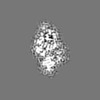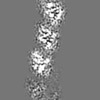+ Open data
Open data
- Basic information
Basic information
| Entry |  | ||||||||||||
|---|---|---|---|---|---|---|---|---|---|---|---|---|---|
| Title | A Cbc-ParM filament with GDP | ||||||||||||
 Map data Map data | |||||||||||||
 Sample Sample |
| ||||||||||||
 Keywords Keywords | ParM actin-like plasmid segregation / CELL CYCLE | ||||||||||||
| Function / homology | :  Function and homology information Function and homology information | ||||||||||||
| Biological species |   Clostridium botulinum Bf (bacteria) Clostridium botulinum Bf (bacteria) | ||||||||||||
| Method | helical reconstruction / cryo EM / Resolution: 3.5 Å | ||||||||||||
 Authors Authors | Koh A / Ali S / Robinson R / Narita A | ||||||||||||
| Funding support |  Japan, 3 items Japan, 3 items
| ||||||||||||
 Citation Citation |  Journal: J Biol Chem / Year: 2025 Journal: J Biol Chem / Year: 2025Title: Bacterial genome-encoded ParMs. Authors: Samson Ali / Adrian Koh / David Popp / Kotaro Tanaka / Yoshihito Kitaoku / Naoyuki Miyazaki / Kenji Iwasaki / Kaoru Mitsuoka / Robert C Robinson / Akihiro Narita /    Abstract: ParMs generally exist on low-copy number plasmids where they contribute to plasmid segregation and stable inheritance. We carried out bioinformatics analysis, which indicated that ParM genes are not ...ParMs generally exist on low-copy number plasmids where they contribute to plasmid segregation and stable inheritance. We carried out bioinformatics analysis, which indicated that ParM genes are not only confined to plasmids but are also occasionally found on genomes. Here we report the discovery and characterization of two chromosome-encoded ParMs (cParMs) from the genomes of Desulfitobacterium hafniense (Dh-cParM1) and Clostridium botulinum (Cb-cParM). Both cParMs form filaments, exhibit nucleotide hydrolysis, and possess characteristic ParM subunit structures. Dh-cParM1 forms single and tightly coupled double filaments and is highly conserved on the chromosomes of five of six Desulfitobacterium species. Interestingly, these bacteria have not been reported to harbor plasmids. Cb-cParM possesses unique properties. Its filaments were stable after nucleotide hydrolysis and Pi release, and its ParR (Cb-cParR) did not affect the initial phase of Cb-cParM polymerization but displayed properties of a depolymerization factor for mature filaments. These results indicate functional, polymerizing ParMs can be encoded on genomes, suggesting that ParM roles may extend to other functions beyond plasmid segregation. | ||||||||||||
| History |
|
- Structure visualization
Structure visualization
| Supplemental images |
|---|
- Downloads & links
Downloads & links
-EMDB archive
| Map data |  emd_33009.map.gz emd_33009.map.gz | 6.4 MB |  EMDB map data format EMDB map data format | |
|---|---|---|---|---|
| Header (meta data) |  emd-33009-v30.xml emd-33009-v30.xml emd-33009.xml emd-33009.xml | 16.7 KB 16.7 KB | Display Display |  EMDB header EMDB header |
| FSC (resolution estimation) |  emd_33009_fsc.xml emd_33009_fsc.xml | 13.6 KB | Display |  FSC data file FSC data file |
| Images |  emd_33009.png emd_33009.png | 72 KB | ||
| Filedesc metadata |  emd-33009.cif.gz emd-33009.cif.gz | 6.3 KB | ||
| Archive directory |  http://ftp.pdbj.org/pub/emdb/structures/EMD-33009 http://ftp.pdbj.org/pub/emdb/structures/EMD-33009 ftp://ftp.pdbj.org/pub/emdb/structures/EMD-33009 ftp://ftp.pdbj.org/pub/emdb/structures/EMD-33009 | HTTPS FTP |
-Validation report
| Summary document |  emd_33009_validation.pdf.gz emd_33009_validation.pdf.gz | 488.7 KB | Display |  EMDB validaton report EMDB validaton report |
|---|---|---|---|---|
| Full document |  emd_33009_full_validation.pdf.gz emd_33009_full_validation.pdf.gz | 488.3 KB | Display | |
| Data in XML |  emd_33009_validation.xml.gz emd_33009_validation.xml.gz | 12 KB | Display | |
| Data in CIF |  emd_33009_validation.cif.gz emd_33009_validation.cif.gz | 16.4 KB | Display | |
| Arichive directory |  https://ftp.pdbj.org/pub/emdb/validation_reports/EMD-33009 https://ftp.pdbj.org/pub/emdb/validation_reports/EMD-33009 ftp://ftp.pdbj.org/pub/emdb/validation_reports/EMD-33009 ftp://ftp.pdbj.org/pub/emdb/validation_reports/EMD-33009 | HTTPS FTP |
-Related structure data
| Related structure data |  7x56MC  7x54C 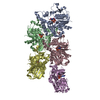 7x55C 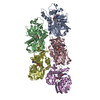 7x59C  8x1iC M: atomic model generated by this map C: citing same article ( |
|---|---|
| Similar structure data | Similarity search - Function & homology  F&H Search F&H Search |
- Links
Links
| EMDB pages |  EMDB (EBI/PDBe) / EMDB (EBI/PDBe) /  EMDataResource EMDataResource |
|---|
- Map
Map
| File |  Download / File: emd_33009.map.gz / Format: CCP4 / Size: 30.5 MB / Type: IMAGE STORED AS FLOATING POINT NUMBER (4 BYTES) Download / File: emd_33009.map.gz / Format: CCP4 / Size: 30.5 MB / Type: IMAGE STORED AS FLOATING POINT NUMBER (4 BYTES) | ||||||||||||||||||||||||||||||||||||
|---|---|---|---|---|---|---|---|---|---|---|---|---|---|---|---|---|---|---|---|---|---|---|---|---|---|---|---|---|---|---|---|---|---|---|---|---|---|
| Projections & slices | Image control
Images are generated by Spider. | ||||||||||||||||||||||||||||||||||||
| Voxel size | X=Y=Z: 0.87 Å | ||||||||||||||||||||||||||||||||||||
| Density |
| ||||||||||||||||||||||||||||||||||||
| Symmetry | Space group: 1 | ||||||||||||||||||||||||||||||||||||
| Details | EMDB XML:
|
-Supplemental data
- Sample components
Sample components
-Entire : CBg-ParM filament with GDP
| Entire | Name: CBg-ParM filament with GDP |
|---|---|
| Components |
|
-Supramolecule #1: CBg-ParM filament with GDP
| Supramolecule | Name: CBg-ParM filament with GDP / type: complex / ID: 1 / Parent: 0 / Macromolecule list: #1 |
|---|---|
| Source (natural) | Organism:  |
-Macromolecule #1: Cbc-ParM
| Macromolecule | Name: Cbc-ParM / type: protein_or_peptide / ID: 1 / Number of copies: 5 / Enantiomer: LEVO |
|---|---|
| Source (natural) | Organism:  Clostridium botulinum Bf (bacteria) Clostridium botulinum Bf (bacteria) |
| Molecular weight | Theoretical: 32.545352 KDa |
| Recombinant expression | Organism:  |
| Sequence | String: MKITVVDLGN INVKYVGENK GRFSSKITND YQSYEEGFQR VEYNGIKTYI GVGELSREFN KADRDYMAQL LYSLAKANTA DTKEINLTL LLPIIQMKNK TRLIETLKGE NFKFKFNGID REIKINDLMV LPEGYASYYS LDIENKKGDV CILDLGSRTI N ICVLENAK ...String: MKITVVDLGN INVKYVGENK GRFSSKITND YQSYEEGFQR VEYNGIKTYI GVGELSREFN KADRDYMAQL LYSLAKANTA DTKEINLTL LLPIIQMKNK TRLIETLKGE NFKFKFNGID REIKINDLMV LPEGYASYYS LDIENKKGDV CILDLGSRTI N ICVLENAK IVKTNTIKLG SFDFYSKIKS LENAKGEDYI EEDIQRLIDN GLIKVDSKQY IEFLSDILNA VKPYVNLKTY NT IFTGGTS LMLKEYIEKL PLNKFKVHPN ALTSNVDGAM EASKKVWN UniProtKB: UNIPROTKB: A0A6B3ZKE5 |
-Macromolecule #2: GUANOSINE-5'-DIPHOSPHATE
| Macromolecule | Name: GUANOSINE-5'-DIPHOSPHATE / type: ligand / ID: 2 / Number of copies: 5 / Formula: GDP |
|---|---|
| Molecular weight | Theoretical: 443.201 Da |
| Chemical component information | 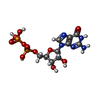 ChemComp-GDP: |
-Macromolecule #3: MAGNESIUM ION
| Macromolecule | Name: MAGNESIUM ION / type: ligand / ID: 3 / Number of copies: 5 / Formula: MG |
|---|---|
| Molecular weight | Theoretical: 24.305 Da |
-Experimental details
-Structure determination
| Method | cryo EM |
|---|---|
 Processing Processing | helical reconstruction |
| Aggregation state | filament |
- Sample preparation
Sample preparation
| Concentration | 0.7 mg/mL | ||||||||||||
|---|---|---|---|---|---|---|---|---|---|---|---|---|---|
| Buffer | pH: 7.5 Component:
| ||||||||||||
| Grid | Model: Quantifoil / Material: MOLYBDENUM / Mesh: 400 / Pretreatment - Type: GLOW DISCHARGE / Pretreatment - Time: 30 sec. / Pretreatment - Atmosphere: AIR | ||||||||||||
| Vitrification | Cryogen name: ETHANE / Chamber humidity: 90 % / Chamber temperature: 298 K / Instrument: LEICA EM GP |
- Electron microscopy
Electron microscopy
| Microscope | FEI TITAN KRIOS |
|---|---|
| Image recording | Film or detector model: FEI FALCON III (4k x 4k) / Average electron dose: 45.0 e/Å2 |
| Electron beam | Acceleration voltage: 300 kV / Electron source:  FIELD EMISSION GUN FIELD EMISSION GUN |
| Electron optics | Illumination mode: FLOOD BEAM / Imaging mode: BRIGHT FIELD / Nominal defocus max: 3.0 µm / Nominal defocus min: 1.0 µm |
| Experimental equipment |  Model: Titan Krios / Image courtesy: FEI Company |
 Movie
Movie Controller
Controller



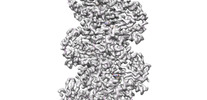




 Z (Sec.)
Z (Sec.) Y (Row.)
Y (Row.) X (Col.)
X (Col.)







